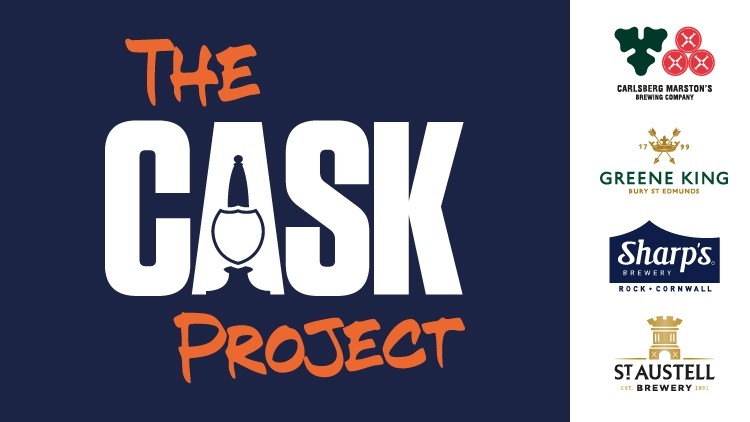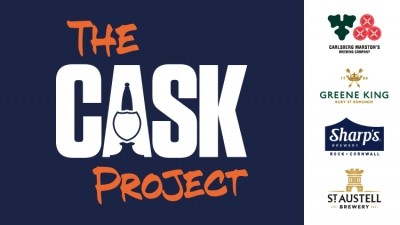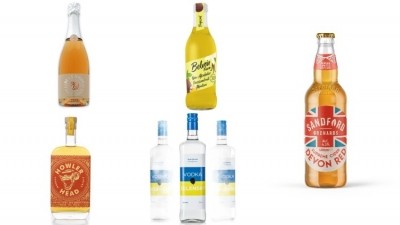the cask project
Is it time to reform the tradition of cask beer?

The Cask Project
The Morning Advertiser launched The Cask Project in a bid to re-energise the category and reinstall it in pride of place on the bar of pubs throughout the country.
Cask beer is in long-time decline and, having joined forces with some of the UK’s leading cask beer suppliers – Carlsberg Marston’s Brewing Company, Greene King, Sharp’s Brewery and St Austell – we want to reinvigorate attitudes within the trade to a product which should be rightly cherished by operators.
Cask beer is a unique product that can only be replicated successfully within pubs but the perception of cask, particularly among younger drinkers, is that it is made and loved only by an ageing male population.
We want to create a real buzz about cask to get pub owners, operators, general managers, bartenders and all pub staff on board and debunk the myths surrounding the drink and educate them on how to make cask work for their business. And by doing this, we can pass on that knowledge, care and skill into cask beer at the bar for customers to get excited about too.
We hear talk of the decline of cask – not for the first time. If you feel gloomy about it now, you should have been around in 1971 (the year the Campaign for Real Ale (CAMRA) was founded), when it was hard to find cask beer at all. We recovered from that low point through greater public awareness and practical measures to improve quality, including cooled cellars, pythons and better line cleaning. More of the same is needed now.
But first, let’s consider – why bother? What’s the point of cask beer? It’s traditional. Yes – but the same could be said of coal fires and flat caps. Hasn’t cask beer simply had its day? To that, I say a resounding NO! And I’ll explain why.
A digression – think for a moment about tinned peaches. They’re fine – consistent and reliable, long-lasting and convenient. Yet eating them doesn’t compare with the delight of biting into a lovely fresh peach, juicy and sweet. That’s what it’s all about – flavour. Freshness and flavour – and the same applies to beer. End of digression.
Variety
We have plenty to celebrate. There are more than 3,000 breweries in the UK – more than half of them founded in the past decade. They produce a wonderful range of cask and craft beers and that, together with good distribution systems to move beer around the country, gives the publican and the drinker more choice than ever before. Blonde ales, IPAs, bitters, wheat beers, stouts and porters; beers flavoured with spices, fruit or chocolate; or just a good, regular pint. More about craft later.
Quality
Most of the cask beer that I am served in pubs is of good quality. Still, though, I have to say that I come across beer that isn’t up to scratch more often than I should. Understanding the reasons for this and working out how to tackle them is the purpose of this piece.
The first thing to say is that, by and large, the breweries are not to blame. I won’t say that there are no mistakes or bad practices but, in general, it’s good beer that leaves the brewery gate. We must turn our attention to the pub cellar.
Temperature
12oC in glass is usually considered ideal. That’s the same as cellar temperature. Cask Marque allows 10-14oC for full marks. The accepted method of achieving this is to use a separate cooler, just for cask beers, with water at 7–8oC. This water is pumped to the bar in a python and around the beer engines themselves.
Over time, though, the water gets dirty and the circuit around the beer engines often becomes clogged. It needs to be cleaned and flushed out regularly but this raises a problem. Many of these coolers are provided by breweries as an add-on extra (perhaps free of charge) to the equipment they provide for their keg beers, even though they may not offer any cask beers. It’s perhaps not surprising that they are reluctant to put in the effort and cost that’s needed for this routine maintenance. Both brewers and pubs should understand that they need to find a way of reaching agreements and contracts that ensure that equipment is not only supplied but maintained too.
Worse than that: it’s common to find that brewers have not installed separate coolers and pythons for cask beers but have simply included cask lines in their keg beer pythons, circulated with ice-cold water. To compensate for the possible over-cooling, they fail to connect the cooling circuit to the beer engines, leaving the beer that’s in them at room temperature. Beer may end up in the glass anywhere from 5-20oC. My message here is clear – that’s simply not good enough. As I said above, I have sympathy over the question of cost but installing second-rate systems is not the answer. Some of our biggest brewers and pub groups are still installing these systems today.
Beer engines
The first thing to understand is that the good old hand-pump on the bar doesn’t actually pump anything. The beer is driven up the python to the bar by the black pumps on the cellar wall. Mechanically, all that’s needed in the bar is a valve that opens and shuts. A tap, if you like. We retain the beer engine to preserve the traditional image of hand-pulled beer and I’m all for that. Image is an important part of cask beer’s appeal and the beer itself is still as traditional as it ever was.
Some breweries have used, with great success, cylinder-less beer engines. Same action, same image but no beer held in the pump.
And… breathe
Even the best pubs can come up with a poor pint from the end of a cask. That’s not because of dregs or “cask bottoms”. It’s the beer from the top, near the surface. And above that surface is… air. Every time a pint of beer goes out of a cask, a pint of air goes in, and air is the enemy of beer. It carries bacteria that produce the acetic (vinegary) taste that you find in that last pint. That’s also the reason we say that a cask shouldn’t remain on sale for more than three days. In contact with air, it quickly deteriorates. But do we really expect a hard-pressed landlord to throw away half a cask on day four? Seriously?
There is an answer, and it’s been around for years. A “cask breather” allows CO2 (or mixed gas) to be drawn into the cask instead of air. Zero pressure – it doesn’t produce gassy beer, just excludes the air. Like all cask equipment, it has to be cleaned but, other than that, it has no drawbacks.
CAMRA used to object to these (misguidedly, in my opinion) but now endorses their use in the interests of quality.
Casks
Question – how do you know it’s cask beer? Answer – because it comes in a cask, not a keg.
We can lie the cask on a stillage or stand it on end and use an extractor. Either way, we still have to use a mallet to bash a tap through a piece of wood. Is that the best we can do in the 21st century? Isn’t it high time the industry came up with something better?
As a container, the keg is a better prospect. We need to vent the headspace and draw the liquid. Simple adaption of existing technology in brewery and cellar could achieve this. And we should use cask breathers.
We can learn from the craft beers that come in kegs. Some are unfiltered and unpasteurised so are, if anything, more prone to infection and deterioration than cask beer but, by excluding air and serving on gas pressure, we can keep them on sale for one to two weeks.
Line cleaning
We have automatic line-cleaning machines, electronic devices that slow the deposition of solids and technicians who offer a line-cleaning service. All these can work, and so can the old-fashioned method of pulling detergent through the lines and leaving it to soak. What’s important is that you do it – regularly, correctly and conscientiously. No excuses – and keep a record. If you do it when a cask runs empty, you needn’t waste any beer.
And finally – money
Let’s accept that much of our cask beer is produced by small breweries that are, quite rightly, never going to offer equipment and service. Therefore, pubs, both individuals and larger companies, must understand this doesn’t come for nothing. You need to have equipment supplied, installed and maintained and to have lines and accessories cleaned. You may have a contract that provides some of this free of charge, you may do some yourself and you may have to pay for it. But, my plea is, don’t leave yourselves with some pieces of this jigsaw missing. If you do, the reputation of your beer and cask beer generally may suffer. Take pride in your beer so we can all enjoy it.
Steve Housden’s CV includes a PhD from Heriot-Watt Brewing School; brewer at Ushers, Wiltshire; technical services manager at Ushers and Joshua Tetley; senior positions at dispense manufacturers IMI Cornelius and Scotsman; consultant specialising in dispense and beer quality in trade; and Cask Marque assessor and SIBA auditor






